IF 7.3
1区 农林科学
Q1 ENVIRONMENTAL SCIENCES
International Soil and Water Conservation Research
Pub Date : 2025-06-25
DOI:10.1016/j.iswcr.2025.06.005
引用次数: 0
摘要
土壤有机碳(SOC)在高寒生态系统碳循环中起着关键作用;然而,土壤类型和高程梯度对土壤有机碳动态的影响尚不清楚。利用这些信息,研究了两种土壤类型(暗毡土和风成土)和海拔梯度对土壤有机碳动态的影响。结果表明:暗毡土的平均有机碳含量(15.13±5.78 g/kg)显著高于风成土(7.98±2.76 g/kg);暗毡状土壤有机碳含量随海拔升高而持续增加,每升高1000 m增加约23.4 g/kg。相反,由于风成土沙粒含量高,结构疏松多孔,低有机碳含量不随海拔而变化。研究发现,年平均降水量(MAP)、归一化植被指数(NDVI)、电导率(EC)和粘粒含量(clay)是影响暗毡土有机碳积累的主要因素。随着海拔的升高,形成了更加湿润和凉爽的水热环境,显著改善了植被(NDVI),优化了土壤理化性质(粘土和EC)。这些因素协同作用,促进了暗毡质土壤有机碳的积累。本研究强调了暗松软土和风成土对土壤有机碳含量的影响,提高了对高寒地区高海拔地区有机碳积累机制的认识。本文章由计算机程序翻译,如有差异,请以英文原文为准。

Variability of soil organic carbon with elevation gradient in the Yarlung Tsangpo River Basin on the southeastern Tibetan Plateau
Soil organic carbon (SOC) plays a critical role in the carbon cycle of alpine ecosystems; however, little is known about the dynamics of SOC governed by soil types and elevation gradients in these systems. In this study, soil properties, environmental conditions, and anthropogenic activities were identified along an 835 km east-west transect in the Yarlung Tsangpo River of the Tibetan Plateau region, which has an elevation range of 2800–5200 m. The information was used to investigate the effects of two soil types (dark felty soils and aeolian soils) and elevation gradients on SOC dynamics. The findings revealed that the average SOC content in dark felty soil (15.13 ± 5.78 g/kg) was significantly greater than that in aeolian soil (7.98 ± 2.76 g/kg). The SOC content of dark felty soil continuously increased with elevation, increasing by about 23.4 g/kg for every 1000 m increase in elevation. In contrast, owing to the high sand particle content and loose, porous structure of aeolian soil, the low SOC content did not vary with elevation. We found that mean annual precipitation (MAP), normalized difference vegetation index (NDVI), electrical conductivity (EC), and clay content (clay) were the primary factors influencing SOC accumulation in dark felty soils. As elevation increased, a more humid and cool water-thermal environment was formed, significantly improving vegetation (NDVI) and optimizing soil physicochemical properties (clay and EC). These factors interacted synergistically to promote significant SOC accumulation in dark felty soils. This study emphasized the importance of the effects of dark felty soil and aeolian soil on the SOC content and improved the understanding of the mechanism by which SOC accumulates in the alpine region of high elevation areas.
求助全文
通过发布文献求助,成功后即可免费获取论文全文。
去求助
来源期刊

International Soil and Water Conservation Research
Agricultural and Biological Sciences-Agronomy and Crop Science
CiteScore
12.00
自引率
3.10%
发文量
171
审稿时长
49 days
期刊介绍:
The International Soil and Water Conservation Research (ISWCR), the official journal of World Association of Soil and Water Conservation (WASWAC) http://www.waswac.org, is a multidisciplinary journal of soil and water conservation research, practice, policy, and perspectives. It aims to disseminate new knowledge and promote the practice of soil and water conservation.
The scope of International Soil and Water Conservation Research includes research, strategies, and technologies for prediction, prevention, and protection of soil and water resources. It deals with identification, characterization, and modeling; dynamic monitoring and evaluation; assessment and management of conservation practice and creation and implementation of quality standards.
Examples of appropriate topical areas include (but are not limited to):
• Conservation models, tools, and technologies
• Conservation agricultural
• Soil health resources, indicators, assessment, and management
• Land degradation
• Sustainable development
• Soil erosion and its control
• Soil erosion processes
• Water resources assessment and management
• Watershed management
• Soil erosion models
• Literature review on topics related soil and water conservation research
 求助内容:
求助内容: 应助结果提醒方式:
应助结果提醒方式:


